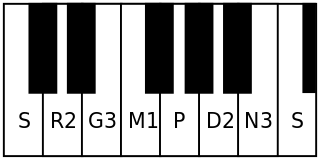Top Qs
Timeline
Chat
Perspective
Arabhi
Janya raga of Carnatic music From Wikipedia, the free encyclopedia
Remove ads
Arabhi or Aarabhi (pronounced ārabhi) is a ragam (musical scale) in Carnatic music (South Indian classical music). It is a Janya raga (derived scale), whose Melakarta raga (parent scale, also known as janaka) is Shankarabharanam, 29th in the 72 Melakarta raga system. It is a combination of the pentatonic scale Shuddha Saveri (or Durga in Hindustani Music) and the sampurna raga scale Shankarabharanam.
This article needs additional citations for verification. (July 2020) |
Arabhi is a raga that dates back to 7 AD. Originally, it was called as pazhanthakkam in Ancient Tamil music[citation needed]. A very auspicious ragam that emanates Veera rasa (valour), Arabhi is one of the five Ghana ragams that shine with special brilliance when Thanam is played on Veena.[1]
Remove ads
Structure and Lakshana
Summarize
Perspective


Its ārohaṇa-avarohaṇa structure (ascending and descending scale) is as follows (see swaras in Carnatic music for details on below notation and terms):
Arabhi raga is an Owdava-sampoorna raga meaning, 5 swaras occur in the arohana (so it is called Owdava) and in avarohana all swaras occur (so sampoorna).
It is a raga without much gamakas and frequency variations, relying instead on flat notes. The important point is the swara "ga" always comes very close to "ma" so when we sing the phrase "ma ga ri" it sounds like "ma ma ri". Likewise the swara "ni" always comes very close to the swara "sa" hence when we sing the phrase "sa ni da" it sounds like "sa sa da".[citation needed]
The closest raga to this one is Devagandhari. There are few aspects which make Arabhi different (though both share the same ascending and desce
- In Arabhi the swara "ga" is close to "ma" but in Devagandhari it is not the same.
- The swara "ri" is not fluctuated in Arabhi but it is given "asaivu" in Devagandhari
- The phrase "pa ma da sa" should not be sung in Arabhi, as it is exclusive for Devagandhari
- Devagandhari is sung with gamakas and vilambita kala prayogas (usages with elongated notes)[2]
- Devagandhari is sung with deergha gandharam (elongated G3)[2]
Arabhi raga is a very energetic and it lends itself to creativity in brigas (fast-paced swara usages) more than gamakas.
Remove ads
Popular Compositions
Summarize
Perspective
The 3rd of Pancharatna Kritis (five gems of compositions), Sadhinchanae(also known as "Samayaniki Tagu Mataladene") by Saint Thyagaraja is a famous composition set in Arabhi raga. Here we can note that Thyagaraja uses phrases like "sa sa da" in the charanam although there are phrases like "sa ni da" also.
Here are some more compositions set to Arabhi.
Remove ads
Film Songs
Language:Tamil
Title Song
Language: Malayalam
Language: Telugu
Remove ads
Notes
Remove ads
References
External links
Wikiwand - on
Seamless Wikipedia browsing. On steroids.
Remove ads
